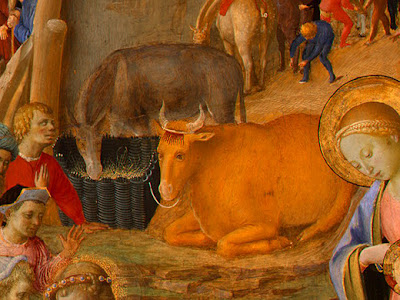Isaiah 1:3 and the Creche Scene
Another painting that has stuck in my mind since our SBL tour was this one by Fra Angelico and Fra Filippo Lippi: Adoration of the Magi, c. 1440/60 ce.

The painting captures the imagination with its sparkling colors and many fascinating details. One feels a sense of festive gaiety as one's eye traces the procession around the circular panel of the work and down to the Christ child on Mary's lap. For a good, basic description of the painting, click here.
For an OT scholar, the most fascinating thing about this painting is that the center of the circle is not the NT nativity scene of Mary and Jesus at all. The center of the circular work is occupied by an ox and an ass/donkey! Here is a close up:

Prof. Tyler Williams over at Codex has recently blogged on two recent, rather conflicting, presentations of the historicity of the traditional nativity scene (click here). As part of this discussion Tyler highlights Geza Vermes's point that the ox and ass in the traditional scene are "alien to the New Testament." So what is their source?
Fascinatingly, they come from Isaiah 1:3, in which God complains, "The ox knows its owner, and the donkey its master's crib; but Israel does not know, my people do not understand."
Well, if you have a "knowing" ox and and "understanding" donkey at Jesus's birth, then certainly Jesus is none other than creation's "owner" and "master." Jesus is also the one who cares deparately about "my people," Israel. He is the one who comes to set right the cruel wrong expressed in Isaiah 1:3. To me, this is the meaning of this beautiful painting.
Needless to say, this specific idea at the heart of this painting is unknown to the NT (and unknown as well to Isaiah 1 in its literary context). What is certainly known to the Scriptures, however, is the fact that the Messiah makes his advent to usher in God's reign as owner and lord of God's own people and indeed of all creation, including the natural world.
Note: The ox and donkey appear in the Creche Scene long before the 15th century painting at issue in this post. They are found already in a unique fourth-century "Nativity" discovered in the St. Sebastian catacombs.
update: for more discussion of Isa 1:3, see John's post (here).
Labels: art
3 Comments:
What an interesting observation...I don't think I'll ever look at a nativity set the same way again!
Thanks, Loren! ---S.
I ran across your comments here after putting together a post on the same topic at www.ancienthebrewpoetry.typepad.com
I added a reference to this entry. It seems to me that we are on the same page.
Post a Comment
<< Home